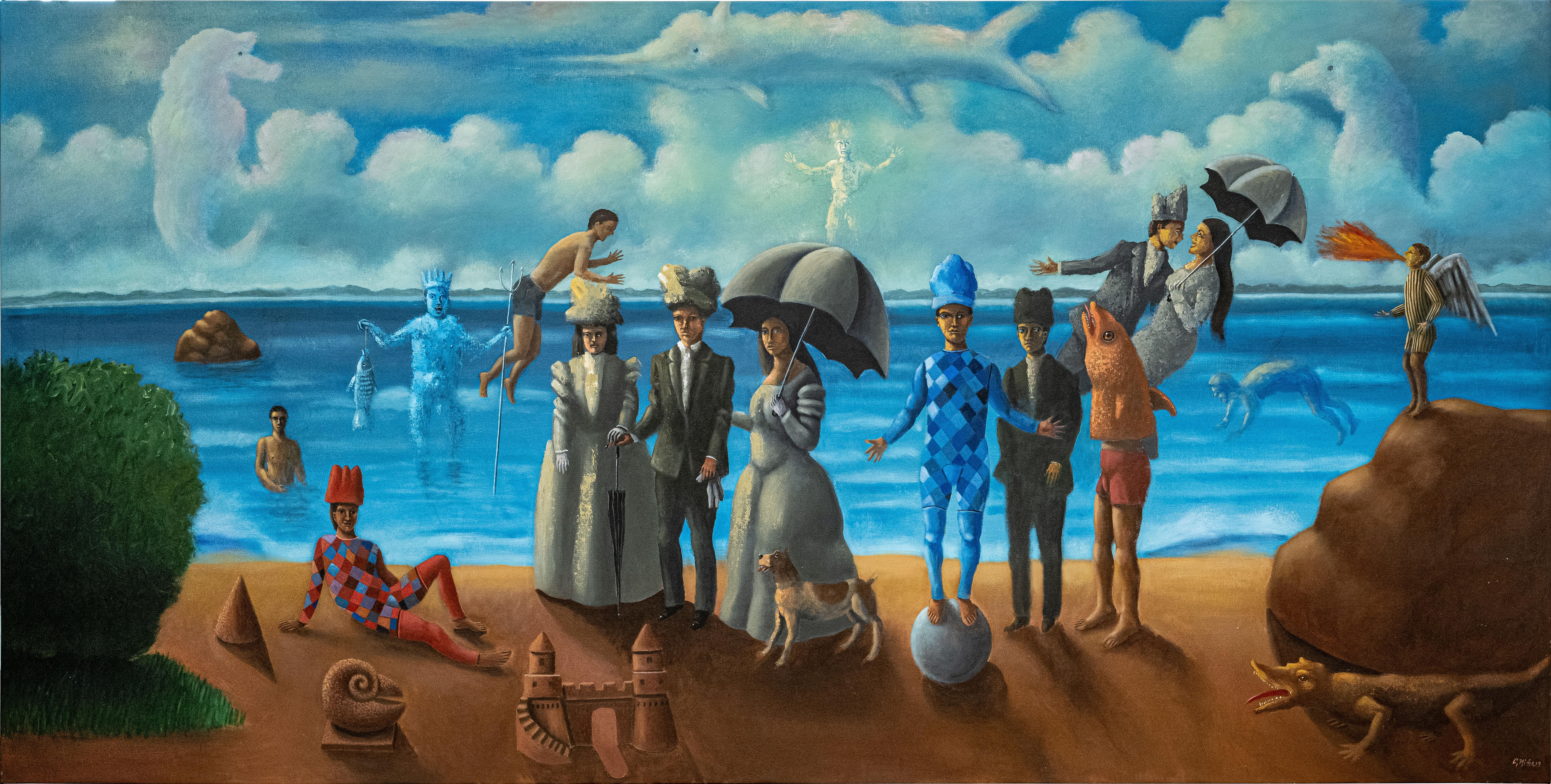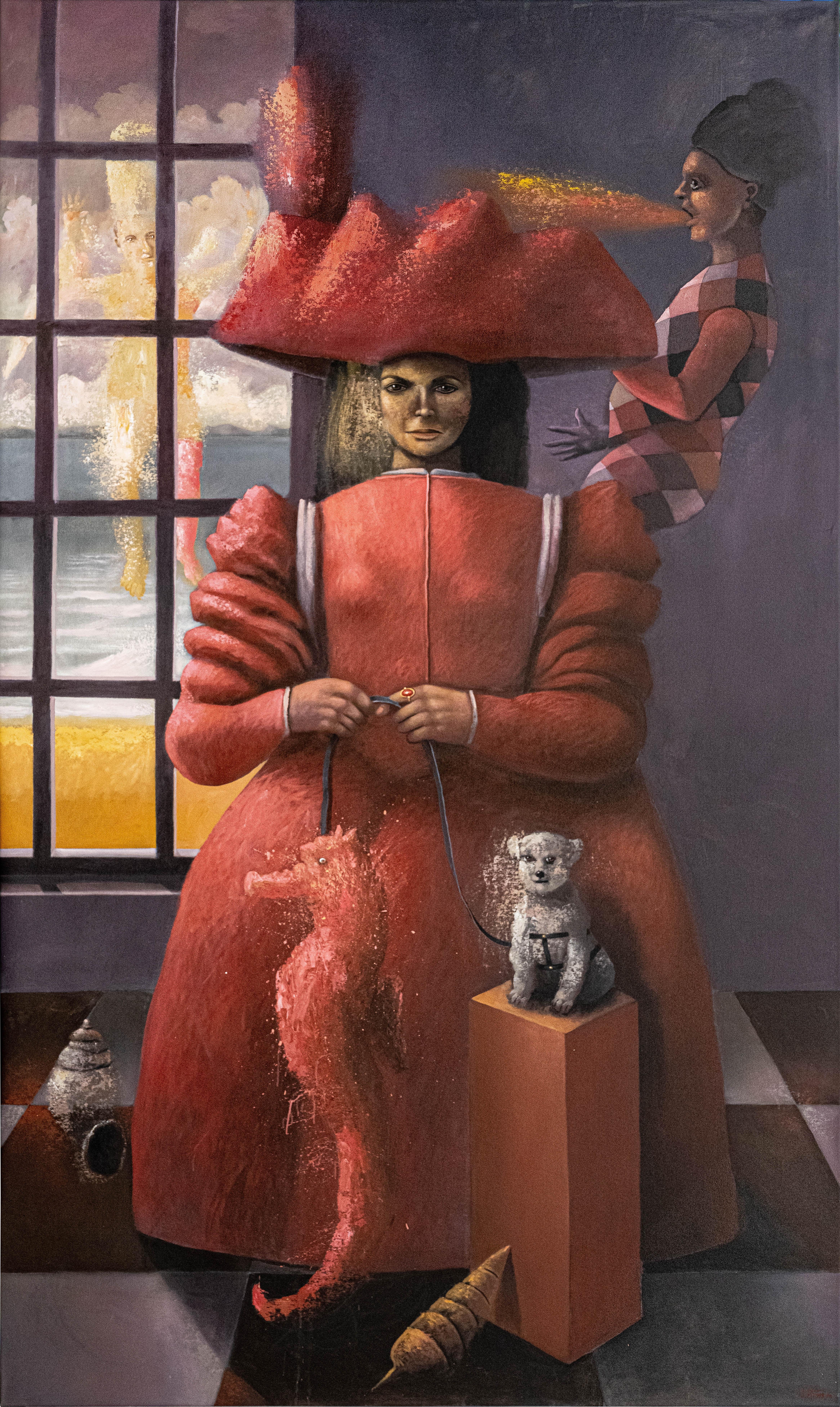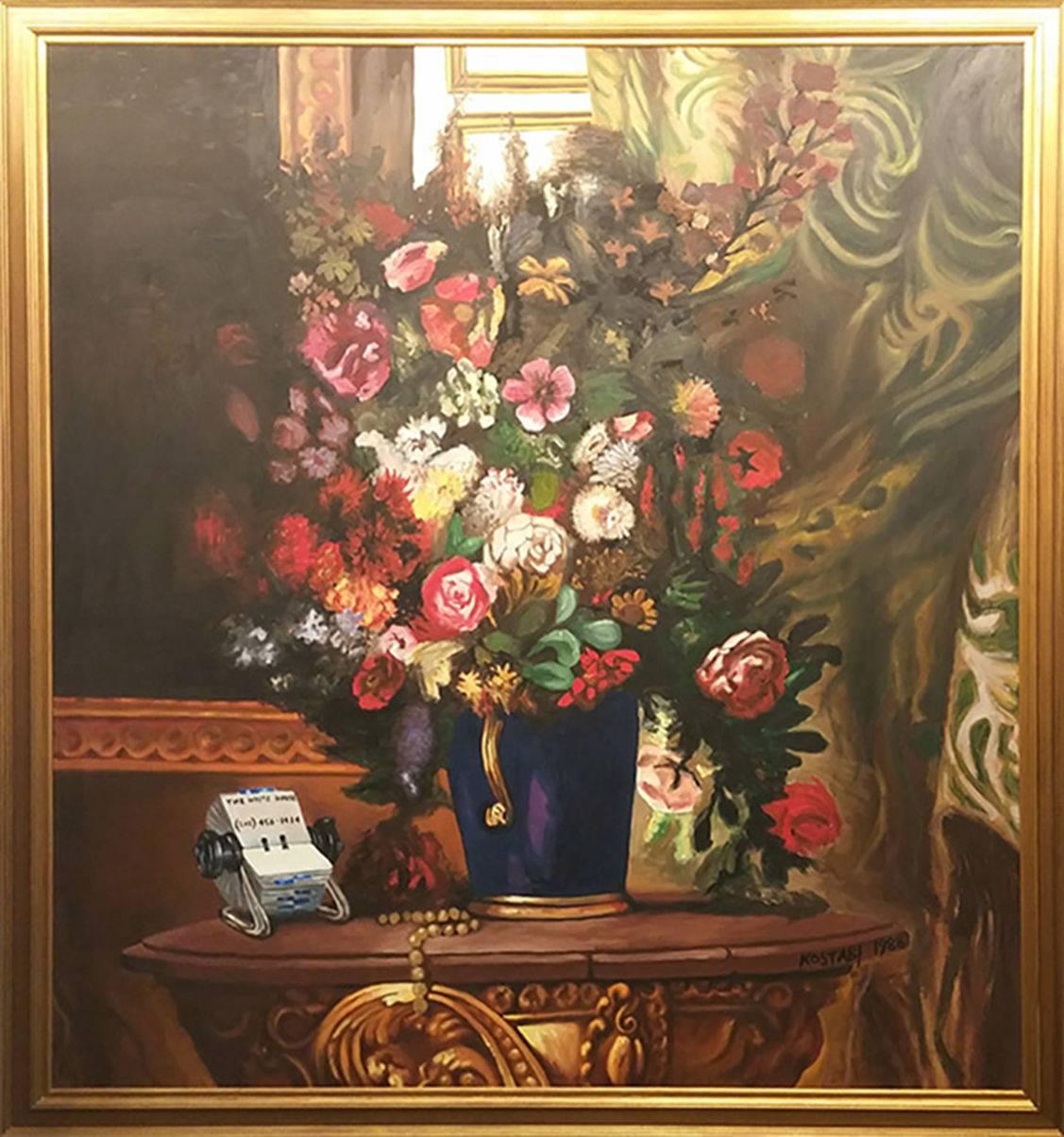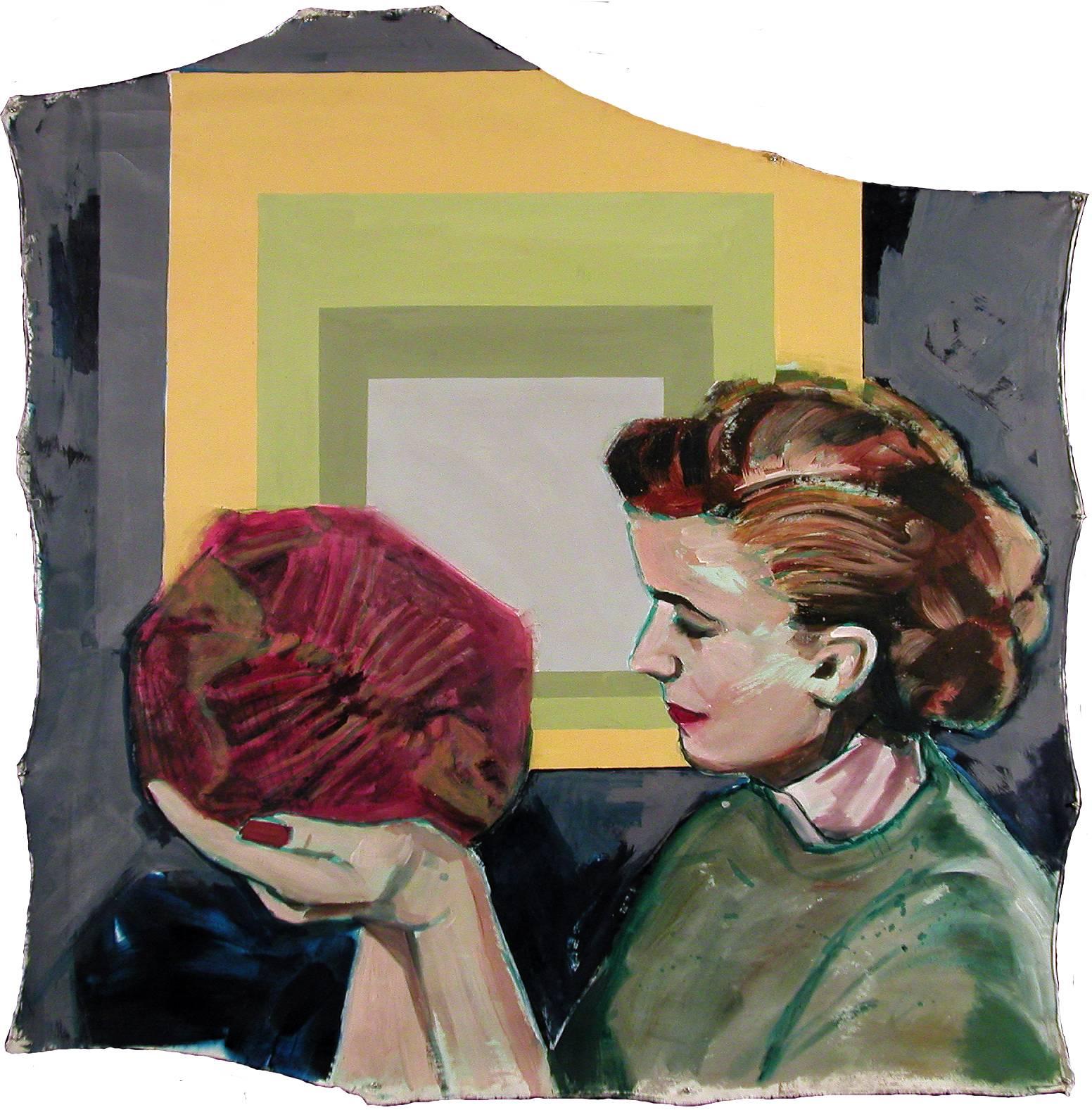Items Similar to Time
Want more images or videos?
Request additional images or videos from the seller
1 of 4
Linda ChristensenTime
About the Item
“I begin this short essay with my artists’ statement from 1997 because it illustrates my focus on emotion instead of on subject matter starting early on. I approached the idea of writing about what I paint back then with dread and tried to bypass it by being as honest as possible about my process. I’d like to think that I paint anything I want because through paint I can express how I feel.
I started training to be an artist in early childhood. I studied texture. I learned about composition. I played with color and observed the beauty of line. My methods were unconventional and invented by me. Many different things inspired me: Cheerios in milk, clouds, hands in food, dry dusty dirt, wet mud puddles, coloring books, fashion photos in the newspaper and my keen need to observe my surroundings. When asked what I wanted to be when I grew up I had no answer. I just wanted to watch, and to observe the world around me.
I’ve worked for years on a response to that complicated question “what is the work about?” I’ve developed all kinds of stories that seem to make sense at the time, but I have to ask, “isn’t this the same question as ‘what do you want to be when you grow up?”’ I am drawn to the figure, and to capturing physical expression in all types of situations, but especially when we are on our own. The body carries emotion, and most people are unaware that they reveal something of themselves when observed in private moments. When I was young I realized that I could easily understand the unspoken just by watching. It felt like a strange and isolating gift – and sometimes a curse – and I often felt confused and acted out in anger when the words didn’t match what I saw. But I still recognize all kinds of emotion there, and whether what I see is true or not, I relish the vulnerability of the moment.
Color is another important tool for me. It’s a self-taught endeavor and one that I explore daily. Color mixing is similar to building flavors in a soup. A soup with just salt is watery and uninteresting. As in cooking, I pay close attention from the first layers what each color feels like in terms of its value, whether it’s warm or cool, and how it fits the composition. I am looking for something that feels harmonious with my nervous system. I begin with abstract shapes, then ask, “Is this shape interesting? Does this color work next to that one? Is it too strong? Is it helpful to the overall composition?” The more complex the mix, the more likely it is to hold my attention, and allow me to linger. Those puddles of paint sitting on my six foot glass palette are essential in setting the stage for what comes next.
Ultimately, my work is a series of self-portraits. I know those poses; I’ve shaded my eyes, I’ve collected on the beach, I’ve weighted a foot. Therefore I don’t closely study how to draw the figure. I don’t necessarily want to get everything “right” or follow the rules, as in my childhood. I want the freedom to show you the flaws and imperfections. I want to feel the emotion that comes with being human, and I want you to feel that too. I know how it feels to be me. In truth, I am not an observer of others but an observer of myself.”
- Creator:Linda Christensen (1950, American)
- Dimensions:Height: 40 in (101.6 cm)Width: 60 in (152.4 cm)
- Medium:
- Period:
- Condition:
- Gallery Location:Park City, UT
- Reference Number:1stDibs: LU483313883242
About the Seller
5.0
Vetted Seller
These experienced sellers undergo a comprehensive evaluation by our team of in-house experts.
Established in 2004
1stDibs seller since 2016
33 sales on 1stDibs
- ShippingRetrieving quote...Ships From: Park City, UT
- Return PolicyThis item cannot be returned.
More From This SellerView All
- Green DressBy Linda ChristensenLocated in Park City, UT“I begin this short essay with my artists’ statement from 1997 because it illustrates my focus on emotion instead of on subject matter starting early on. I approached the idea of writing about what I paint back then with dread and tried to bypass it by being as honest as possible about my process. I’d like to think that I paint anything I want because through paint I can express how I feel. I started training to be an artist in early childhood. I studied texture. I learned about composition. I played with color and observed the beauty of line. My methods were unconventional and invented by me. Many different things inspired me: Cheerios in milk, clouds, hands in food, dry dusty dirt, wet mud puddles, coloring books, fashion photos in the newspaper and my keen need to observe my surroundings. When asked what I wanted to be when I grew up I had no answer. I just wanted to watch, and to observe the world around me. I’ve worked for years on a response to that complicated question “what is the work about?” I’ve developed all kinds of stories that seem to make sense at the time, but I have to ask, “isn’t this the same question as ‘what do you want to be when you grow up?”’ I am drawn to the figure, and to capturing physical expression in all types of situations, but especially when we are on our own. The body carries emotion, and most people are unaware that they reveal something of themselves when observed in private moments. When I was young I realized that I could easily understand the unspoken just by watching. It felt like a strange and isolating gift – and sometimes a curse – and I often felt confused and acted out in anger when the words didn’t match what I saw. But I still recognize all kinds of emotion there, and whether what I see is true or not, I relish the vulnerability of the moment. Color is another important tool for me. It’s a self-taught endeavor and one that I explore daily. Color mixing is similar to building flavors in a soup. A soup with just salt is watery and uninteresting. As in cooking, I pay close attention from the first layers what each color feels like in terms of its value, whether it’s warm or cool, and how it fits the composition. I am looking for something that feels harmonious with my nervous system. I begin with abstract shapes, then ask, “Is this shape interesting? Does this color work next to that one? Is it too strong? Is it helpful to the overall composition?” The more complex the mix, the more likely it is to hold my attention, and allow me to linger. Those puddles of paint sitting on my six foot glass palette...Category
2010s Figurative Paintings
MaterialsCanvas, Acrylic
- Tennis LessonBy Lisa GolightlyLocated in Park City, UTLisa Golightly's initial focus was photography, the influence of which can be seen in her paintings. Her work revolves around memory and how snapshots shape, influence, change and even create memory. She works with acrylic and high gloss enamel, using found photos...Category
2010s Realist Figurative Paintings
MaterialsAcrylic
- WaterlineBy Lisa GolightlyLocated in Park City, UTLisa Golightly's initial focus was photography, the influence of which can be seen in her paintings. Her work revolves around memory and how snapshots shape, influence, change and even create memory. She works with acrylic and high gloss enamel, using found photos...Category
2010s Contemporary Figurative Paintings
MaterialsAcrylic
- Bikini KillBy Brad OvertonLocated in Park City, UT"I have always loved the patina of old toys, wagons, cars. I love the look of time and timelessness. A thing never becomes really beautiful until it is washed by use and attention. I...Category
2010s Figurative Paintings
MaterialsCanvas, Oil
- Gold RushBy Brad OvertonLocated in Park City, UT"I have always loved the patina of old toys, wagons, cars. I love the look of time and timelessness. A thing never becomes really beautiful until it is washed by use and attention. I...Category
2010s Figurative Paintings
MaterialsCanvas, Oil
- Reading Out LoudBy Chris GwaltneyLocated in Park City, UTCHRIS GWALTNEY is a painter from Southern California. He paints in a lush style, combining areas of abstraction with loose figurative elements. He experiments with sensuous surface...Category
2010s Figurative Paintings
MaterialsLinen, Oil
You May Also Like
- Carmelo Niño, Amantes con escena, 2019, 200 x 400 cm, 78.7 x 157.4 in.By Carmelo NiñoLocated in Miami, FLCarmelo Niño Amantes con escena, 2019 Acrylic on canvas 200 x 400 cm 78.7 x 157.4 in. The work is accompanied by a certificate of authenticity signed b...Category
2010s Surrealist Figurative Paintings
MaterialsCanvas, Acrylic
- Carmelo Niño, Carolina niña con Marina, 2021, 350 x 200 cm, 137.7 x 78.7 in.By Carmelo NiñoLocated in Miami, FLCarmelo Niño Carolina niña con Marina, 2021 Acrylic on canvas 350 x 200 cm 137.7 x 78.7 in. The work is accompanied by a certificate of authenticity signed by the artist. Carmelo Niño, a Venezuelan artist originally from Maracaibo, Zulia State, an oil-producing region of Venezuela, is today one of the most outstanding painters in the plastic arts landscape in the country. Many years have passed since his birth in 1951 to the present, when he inaugurates this August 2022, a major exhibition at the Ascaso Gallery in Miami, with paintings from different dates resulting from the permanent and daily work of reflection, physical and intellectual, that he has always pursued in his creative life. Without neglecting a single moment of day-to-day life to be in front of the medium-sized canvas on the easel or of larger canvas hanging on a wall, he works in his large studio in the area of El Junco, outside the capital city of Caracas, surrounded by lush green vegetation, with a wonderful climate of pleasant temperature and poetic mist that invites to the reverie and glorification of his life as a painter. From a very early age Niño and his family discovered his vocation for drawing, a discipline in which he showed a special disposition and talent. From this moment on he dedicates his life to art, to the practice of painting, starting from a fantastic and strange world of fantasy, close to surrealism, unfailingly influenced by the circus of fantasy owned by his mother and a musician father. These circumstances will shape the artist's life. His traces and influences from the beginning will be present in his creative work, especially through the memories of the infinite curiosity to look, touch and be enraptured by the strange furniture and objects from his mother's circus that he knew were deposited in a room of the house. This universe of fantasy will leave an indelible mark on his subconscious and will serve as the thematic and artistic support for all his work. In an interview conducted by the critic Roberto Montero Castro in 1977, Carmelo Niño states, "the symbols of my painting come from the everyday life". His life has been one of continuous work and effort. At the age of fifteen he enrolled in the School of Arts of Maracaibo, graduated three years later, 1966, and immediately, with a scholarship, he travelled to Spain, took a few courses at the San Fernando Academy in Madrid, strengthened his preparation in art workshops and in frequent visits to the big museums of this European capital. With a sensitive gaze he penetrates the mysteries of masterpieces of the great artists who have made the universal history of art. His life as a painter has been intense, of intense study, preparation and work. With much composure and modesty he talks about his life and his artistic production, recognized not only in Venezuela, but also internationally. His participation in exhibitions began in 1969 and as early as 1970 he held his first individual exhibition at the Fine Arts Center of Maracaibo. From these dates onwards successes started to come, with the participation in collective and individual exhibitions, in Venezuela and abroad, as well as the awards from 1971, when he won the Scholarship Award at the First National Salon of Young Artists in Maracay, Aragua State; in 1972 he was awarded the Second Prize at the Regional Salon of Maracaibo. 1975 is the year of awards, he received the First Prize at the IV Salon of Young Artists in Caracas; the Aurelio Rodriguez Award at the IV Avellan Salon in Caracas and the First Prize at the Salon of Young Zulian Artists in Maracaibo; he also participated in the group exhibition of History of Painting in Venezuela, at Casa de Las Americas, Havana, Cuba; and in 1976 he was invited by Jose Gomez Sicre to take part in the exhibition of Venezuelan painting...Category
2010s Surrealist Figurative Paintings
MaterialsCanvas, Acrylic
- BOUQUETBy Mark KostabiLocated in Aventura, FLOriginal painting on canvas. Hand signed and dated on front; Signed, titled and dated on verso by the artist. Artwork is in excellent condition. Certificate of authenticity included...Category
1980s Pop Art Interior Paintings
MaterialsCanvas, Acrylic
- Rustics: Winter Hunting LodgeBy Hannah BarrettLocated in Boston, MAHannah Barrett’s paintings imagine a colorful, absurdist world inhabited by eccentrics of ambiguous genders and time periods. With tongue-in-cheek nods to the past, Barrett combines...Category
2010s Contemporary Figurative Paintings
MaterialsCanvas, Oil, Acrylic
- Rustics: Spring WeekendersBy Hannah BarrettLocated in Boston, MAHannah Barrett’s paintings imagine a colorful, absurdist world inhabited by eccentrics of ambiguous genders and time periods. With tongue-in-cheek nods to the past, Barrett combines...Category
2010s Contemporary Figurative Paintings
MaterialsCanvas, Oil, Acrylic
- Neo GeologyBy Bruce AdamsLocated in Buffalo, NYBruce Adams is best known as a conceptually based figurative painter who references various (often historical) painting styles. In exploring the act of painting, Adams peels back the...Category
1980s Contemporary Figurative Paintings
MaterialsAcrylic, Canvas
Recently Viewed
View AllMore Ways To Browse
Time Out
I Could Feel You
Art Glass Shade Painted
Artist Palette Watch
Cooking Paintings
Nervous System
Complicated Watches
Strange Dirt
Mud Figure
Box Car
African American Collage
Indian Woman Art
Painting Pre War
Aix En Provence
Child Painting Beach
Continental Figures
Donkeys In Art
Framed Oil Paintings On Copper




